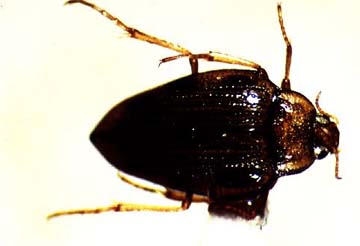Brychius hungerfordi , Hungerford’s Crawling Water Beetle |
|---|
Hungerford’s Crawling Water Beetle is roughly a ¼ of an inch long, and is yellowish brown in color. It is an endangered species found in only five locations in Michigan and Ontario, Canada. Of these five sites, only one is considered to be currently stable or recovering. Their unique range suggests that the HCW beetle lived in streams that were fed by glaciers. These cold fast streams were ideal habitats for the HCWB. When the glaciers receded, the beetles became isolated and the population decreased greatly. Currently, the beetles are found in cold streams, often below beaver dams or other structures that create similar conditions. The life history of the HCWB is largely unknown. It is thought to have a similar life cycle to other closely related beetles. The eggs are probably laid in the early Spring and Summer. The larvae probably molt three times before pupating in moist soil above the water line. The adults and larvae are both herbivorous, but are not usually found together because they inhabit different parts of streams. The larvae are often found among areas of dense aquatic vegetation, a microenvironment that provides food and shelter. The adult stage is most commonly found in areas with stronger currents, feeding on algae growing on rocks in the stream. Adult beetles seldom fly, and it is thought that the main mode of dispersal is by moving within the stream system. This hypothesis coincides with the idea that the receding glaciers caused the HCWB to become geographically isolated. Hungerford’s Crawling Water Beetle was listed as endangered under the Endangered Species Act on March 7th, 1994. A draft of the recovery plan was created in August, 2004, 10 years after being added to the list. The draft states that more research is needed on HCWB in order to determine the best path of action. The immediate goal of the recovery plan is to reduce the classification of the HCWB to threatened status. Full recovery of the species, according to the report, may occur by 2030. In order for this goal to become a reality, more research must be done and all five habitats must be protected from negative modification.
|
Resources: USFWS Hungerford's Crawling Water Beetle Draft Recovery Plan Grant et al. 2002. "Size estimates of a local population of Brychius hungerfordi (Coleoptera: Haliplidae)". The Great Lakes Entomological Socierty of Canada. 155:125-140 |
Written by: Michael Bolling, 2006 Last Update: Eric Denemark, 2008. |
Image credit: U.S. Fish and Wildlife Service |
